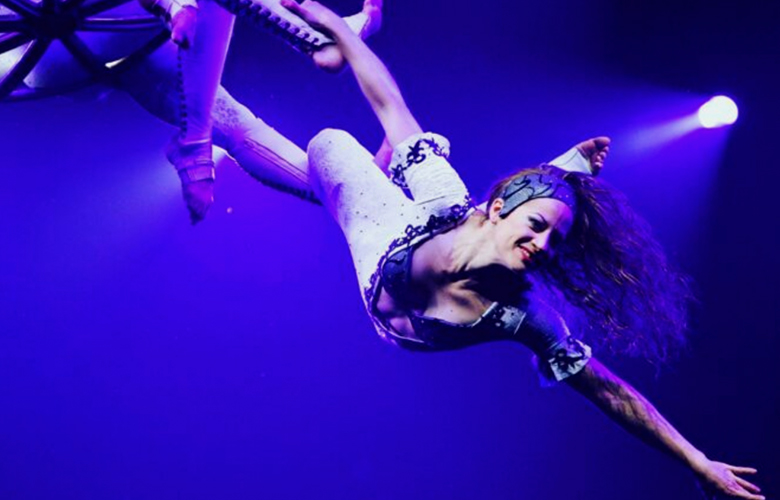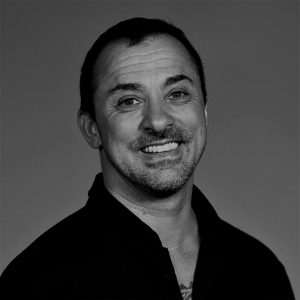
Las Vegas And Le Rêve. Two names which at the moment move the entertainment industry. Las Vegas, a town we thought would never slow down. And Le Rêve, a legendary show we thought will not close its doors for many more years. Covid-19 has changed the world. Especially the live entertainment world. Marin Britten, former acrobat for both Cirque du Soleil’s LOVE and Dragone’s Le Rêve shares her thoughts with us.
Marin grew up in the UK. She completed a law degree as well as a Masters in sociology. After finishing university, Marin created and ran a family restaurant business in Bristol harbour.
In 2008, she was offered to join Cirque du Soleil’s LOVE. Thus, her life in Las Vegas began.
In LOVE, Marin worked primarily as a GOPI (contortion rope artist). However, she also did couple’s bungee, dance numbers, back-up hippie, the nurse role, etc. She left the show in 2012.
In the same year, Marin joined Le Rêve, where she held the generalist role. She was part of the Sphere act and also did the Bell role in Winter and the Yotator role in Beam of Light. She left Le Rêve in 2019.
“Le Rêve seemed pretty solid. The Wynn needs to be 5-star, and Le Rêve was always the Wynn’s baby. It was never just left to sit. It always had aspirations to improve.”
“Le Rêve was one of those shows where people come in and then end their career there. Because they believe in the show. It is a good place to be. That’s why a good number of originals were still in the show. Over the years, they carried it. They were the heart and soul.”
“People found things in Le Rêve to inspire them. Then, they kept working on it for years and years.”
“Often, in other shows, the situation is more that of a passing through for most artists. When the overall atmosphere is more business-like then this passes on to the performers. They become more business-like as well and move on when a new opportunity presents itself.”
“But Le Rêve was pretty much its own entity. Once people got in they found it hard to leave.”
“That is why the closing of the show is incredibly hard for the people of Le Rêve.”
“The show was a life force. A living organism.”
”It is hard for everyone. A lot of my friends thought they would finish their careers there. Many of the original performers have settled in Las Vegas and have families. Others were just simply not expecting to rebuild their career right then and there.”
“The unspoken-about thing: At some point in your life you have to find a new career. You get to the very top. You get to a world-class show. Bring all your energy and skills. And then, at some point, it’s like, ok, go find something else.”
“This is one of the injustices of our career. An un-highlighted injustice. There is no safety.”
“I am more prepared for this moment than most, because I acquired a varied skill set before I joined the circus world.”
“But, it’s that passion we need to do our work that also enables companies to exploit their employees. We are essentially the best in our profession. If we worked in any other career this would come with many perks and privileges. Yet in circus, everyone assumes we are ok, because it is our passion. It is an exploitation of art. You turn it into a business. Without offering the right compensation. Without offering safeguards.”
“It can take 6-12 months to really learn it. That’s a big investment of time and energy.”
“I loved my 4 years with Cirque du Soleil. But I was also ready for a new challenge when I went to Le Rêve.”
“In other shows, everything is kind of set. You just come in and learn your role. In Le Rêve, there was this legacy that you got to feel the creative energy, the process that the artists there went through. When you joined, you picked up on that. I think that’s why many people stayed for so long.” “To be really honest, my experience with LOVE was so much easier than Le Rêve.”
“And in that sense I am glad I did LOVE before I did Le Rêve.”
”In LOVE my experience was that, no matter what caliber artist you are, you have time to grow.”
“Le Rêve was far less forgiving. People had high expectations from the beginning.”
I came in right after Franco Dragone had sold Le Rêve to the Wynn.”
“During creation, Franco Dragone had pushed his cast hard in order to achieve the greatest results. Just like the creativity, this legacy also remained. A toughness which was ingrained in the Le Rêve culture. The original performers who were still there when I joined were also the ones who were the strictest and hardest to new performers.”
“They expected you to hit the ground running. Some people couldn’t handle the pressure and didn’t make it. Thankfully, by the time I joined I was already quite experienced as an artist. I wasn’t too bothered. And I stayed for seven years.”
“It took years for me to adjust and fully enjoy. There was so much discomfort I hadn’t thought of. Ear infections, freezing temperatures during winter, the sogginess, and overall, performing in water was harder on the body.”
“But, the water is also what makes the show spectacular. Aquatic shows are often more spectacular than regular circus shows.”
“I want to emphasize how great it was to be a part of Le Rêve. It was a formative time that pushed me in many ways.”
“Le Rêve is the reason I came to be the aerialist I am today.”
”Plus I made so many wonderful friendships there and had many unforgettable experiences.”
“Looking back now, I remember, just before the news of the closing of Le Rêve, I went to Vegas to visit friends. I went to a training and rehearsal space and assumed it will be full of people training. It wasn’t. The place was dead.”
“I remember thinking, Oh my god, Le Rêve is not coming back. And people know it.”
“I realized it was such an uncertain time. You don’t know if your industry will come back. And it is hard to train for something if you are not sure it will come back.”
“Inevitably, you’ll ask yourself: What am I training for? Am I going to train indefinitely for new opportunities? Or am I going to find a new career and then reconsider if shows do come back?”
“This is the real definition of limbo. It is not just your show that is gone. But also your entire industry is gone.”
“It has gone from dinners and shows, to beach clubs, night clubs, DJs, and conferences. Show attendance numbers have been going down and down.”
“I remember when I started in LOVE in 2008. I was sitting high up on the grid from where I could see the entire auditorium as well. Ushers would bring the audience in one by one.”
“Back then, I asked if it had always been like this. And was told: No. When we opened it was always full. And now we are at 40% capacity.”
“Also since 2008, I remember being in so many company meetings where all we heard about was how many people had come to see the show, what the numbers were compared to last year, etc.”
“Every entertainment business in Vegas has been trying to find out what is happening. With no real answers or solutions as to how to get people back into the auditorium.”
“Fact is, not so many middle-class, middle-aged people are coming to Vegas anymore. Now it is predominantly young people. They are not interested in seeing a show. They are interested in parties, going to the strip, day drinking…”
“There are so many shows as well. Everything has gotten so diffused.”
“I hope what we see from this will be a change to smaller shows. Maybe from now on we will have intimate dinner shows and we will see cabaret-style shows coming back.”
“This would be quite refreshing. And it would be advantageous for circus artists. You’d go back to selling your act as opposed to selling your skills.”
“With the big shows, what happens is that your fee gets decreased by adding other elements to your act. This happens all the time.”
“Don’t get me wrong. I do love big shows and I hope they will survive.”
“But, I think what we will see now is a regeneration of the industry. Which will be a good thing.”
“Maybe we are looking at a 5-year period during which everyone will be struggling.”
“But this crisis can also be a catalyst for creativity.”
“If you work for a big show, you often don’t have time to create anything on the side. Should this turn out to be a revival of smaller shows, then I hope to see an explosion of creativity and variety. It will be great.”
Le Rêve in Las Vegas: A Tribute
Entertainment with A Splash: A History of Aquatic Shows


Liam Klenk was born in Central Europe and has since lived on four continents. Liam has always been engaged in creative pursuits, ranging from photography and graphic design, to writing short stories and poetry, to working in theatre and shows. In 2016, Liam published his first book and memoir, 'Paralian'.
Read Full Profile© 2021 TheatreArtLife. All rights reserved.

Thank you so much for reading, but you have now reached your free article limit for this month.
Our contributors are currently writing more articles for you to enjoy.
To keep reading, all you have to do is become a subscriber and then you can read unlimited articles anytime.
Your investment will help us continue to ignite connections across the globe in live entertainment and build this community for industry professionals.